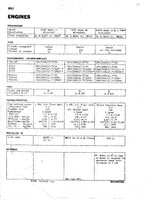- Thread starter
- #61
The D-series engines did yes, but they also had a boost up to 2000hp. The boosted Kasei engine's HP was only 1530. Later higher powered Kasei engines increased in weight, such as the 23 series, which was 860kg and a max boost of 1820hp. Regular HP was 1600hp max vs. the D-series 1700hp.
Over-boosted Kasei (92 oct + water-alcohol injection, from mod. 21 on) were doing 1850+- HP. Includes the mod. 21, 22, 25 and 27 used on big aircraft. 801D with overboost were good for 1900 HP; granted those with C3 injection had perhaps another 50 HP?
1650 HP was the max 'non-boosted' power for the later Kaseis, at least per US data (TAIC manuals can be gotten on the internet for free, also on this site); 92 oct fuel used.
Versions that gained weight beyond 760 kg were the ones with counter-rotating props (for floatplanes) and the ones with extension shaft (for Raiden).
Don't forget the German engine also had the Kommandogerät integrated into the engine, which the Japanese one lacked. The Japanese 23 series engine also apparently had some propellor resonance issues as well. Information is lacking on the Japanese engine, so the limited figures might make it seem better than it really was, while with the BMW 801 we have so much info about it we can see all the warts.
Kommandogerät is certainly a good thing to have, but it will not improve engine capabilities just on itself. Mod. 23 Kasei was a mistake, Japanese should've not bothered with it (it was a version with extension shaft), but just go with 'plain Jane' Kasei on the Raiden and accept a few mph speed loss, while improving reliability and lowering the weight and man-hour requirements.
Information about the Japanese engines can be accessed on this forum, the 'Engine' sub-section is a gold mine.


